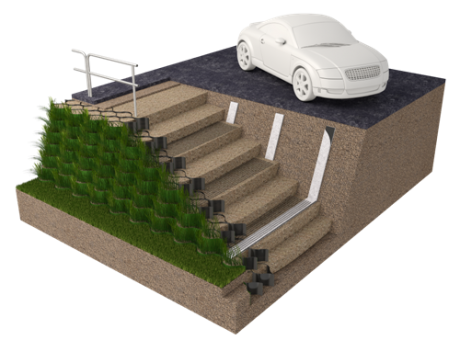Cost savings over traditional earth retaining wall constructions, along with a green vegetated finish can be achieved by using the Webwall system. It is ideal in situations with weak foundation soils and often allows site won materials to be used as fill, thereby saving on the cost of removal and also the cost of importing structural fills.
The retaining wall structure is formed from horizontal layers of Webwall geocell filled and built up in tiers, with each panel being expanded and filled, layer-by-layer, until the required design height is achieved. The front face of the structure can be filled with topsoil and then vegetated through seeding or planting to create a vegetated finish.
Webwall geocell offers many cost advantages over other retaining wall systems; including lower labour costs, cheaper materials and reduced maintenance.

Construction
If the design requires, the structure can be reinforced by integration of a geogrid. As the layers are positioned, the front cells of the wall are filled with top soil and then vegetated, either through seeding or planting. Webwall® can be constructed with a face angle (to the horizontal) up to 70° to ensure there is sufficient step-depth to allow successful planting, essential for the long-term protection of the wall face against UV light. Steeper angles require a protective facing.
Fill Selection
Webwall® constructions are designed to use site arising materials or ‘acceptable’ fill as backfill behind the face panels and around the reinforcing elements (if used). This reduces the need for haulage and consumption of high quality granular materials. Granular materials including crushed rock, concrete or brick are necessary to fill the lower layers of the Webwall® when adjacent to a water course. Very soft clay may not be suitable. Soft or firm clay may be acceptable for small projects where placement and ramming are carried out by hand. If stiff or hard clay is the only material available, it must be broken up by rotavating or by excavating thin slices, to produce gravel size aggregate. The maximum particle size should not exceed 75mm for any backfill material.
Typical Client Profile
- Landscape Architects
- Housing Developers / Retail Developers
- Highways Authorities
- Highways Engineers
- Drainage Consultants
- Local Authorities

